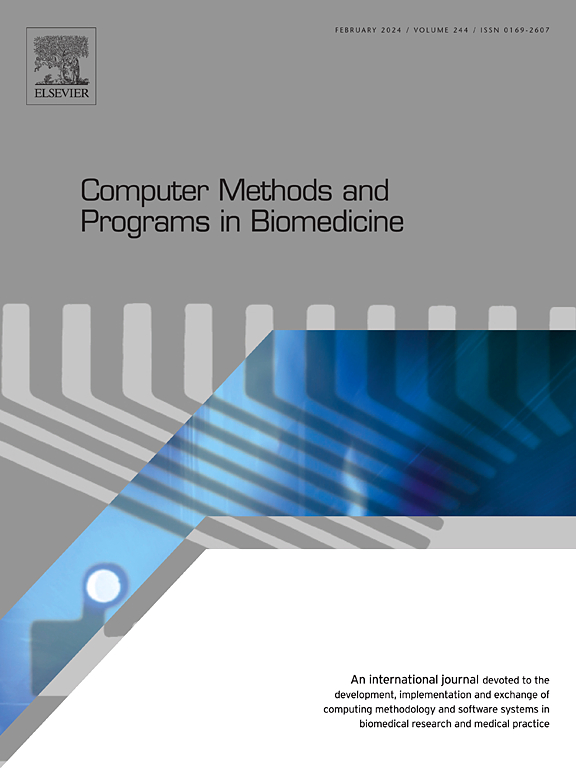Predicting vulnerable coronary arteries: A combined radiomics-biomechanics approach
IF 4.9
2区 医学
Q1 COMPUTER SCIENCE, INTERDISCIPLINARY APPLICATIONS
引用次数: 0
Abstract
Background and Objective
Nowadays, vulnerable coronary plaque detection from coronary computed tomography angiography (CCTA) is suboptimal, although being crucial for preventing major adverse cardiac events. Moreover, despite the suggestion of various vulnerability biomarkers, encompassing image and biomechanical factors, accurate patient stratification remains elusive, and a comprehensive approach integrating multiple markers is lacking. To this aim, this study introduces an innovative approach for assessing vulnerable coronary arteries and patients by integrating radiomics and biomechanical markers through machine learning methods.
Methods
The study included 40 patients (7 high-risk and 33 low-risk) who underwent both CCTA and coronary optical coherence tomography (OCT). The dataset comprised 49 arteries (with 167 plaques), 7 of which (with 28 plaques) identified as vulnerable by OCT. Following image preprocessing and segmentation, CCTA-based radiomic features were extracted and a finite element analysis was performed to compute the biomechanical features. A novel machine learning pipeline was implemented to stratify coronary arteries and patients. For each stratification task, three independent predictive models were developed: a radiomic, a biomechanical and a combined radiomic-biomechanical model. Both k-nearest neighbors (KNN) and decision tree (DT) classifiers were considered.
Results
The best radiomic model (KNN) detected all 7 vulnerable arteries and patients and was associated with a balanced accuracy of 0.86 (sensitivity=1, specificity=0.71) for the artery model and of 0.83 (sensitivity=1, specificity=0.67) for the patient model. The best biomechanical model (DT) detected 6 over 7 vulnerable arteries and patients and remarkably increased the specificity, resulting in a balanced accuracy of 0.89 (sensitivity=0.86, specificity=0.93) for the artery model and of 0.88 (sensitivity=0.86, specificity=0.91) for the patient model. Notably, the combined approach optimized the performance, with an increase in the balance accuracy up to 0.94 for the artery model and up to 0.92 for the patient model, being associated with sensitivity=1 and high specificity (0.88 and 0.85 for artery and patient models, respectively).
Conclusion
This investigation highlights the promise of radio-mechanical coronary artery phenotyping for patient stratification. If confirmed from larger studies, our approach enables a more personalized management of the disease, with the early identification of high-risk individuals and the reduction of unnecessary interventions for low-risk individuals.
预测易损冠状动脉:放射组学与生物力学的结合方法。
背景和目的:目前,冠状动脉ct血管造影(CCTA)检测易损冠状动脉斑块是次优的,尽管对预防主要不良心脏事件至关重要。此外,尽管存在多种易损生物标志物,包括图像和生物力学因素,但准确的患者分层仍然难以捉摸,缺乏综合多种标志物的综合方法。为此,本研究引入了一种创新的方法,通过机器学习方法整合放射组学和生物力学标记来评估易损冠状动脉和患者。方法:40例患者(高危7例,低危33例)均行CCTA和冠状动脉光学相干断层扫描(OCT)。数据集包括49条动脉(含167个斑块),其中7条动脉(含28个斑块)被oct识别为易损动脉。经过图像预处理和分割,提取基于ccta的放射学特征,并进行有限元分析以计算生物力学特征。一种新的机器学习管道被用于冠状动脉和患者分层。对于每个分层任务,开发了三个独立的预测模型:放射组学,生物力学和放射组学-生物力学组合模型。同时考虑了k近邻(KNN)和决策树(DT)分类器。结果:最佳放射组学模型(KNN)检测了所有7条易损动脉和患者,动脉模型的平衡准确度为0.86(敏感性=1,特异性=0.71),患者模型的平衡准确度为0.83(敏感性=1,特异性=0.67)。最佳生物力学模型(DT)检测到6 / 7条易损动脉和患者,特异性显著提高,动脉模型的平衡精度为0.89(敏感性=0.86,特异性=0.93),患者模型的平衡精度为0.88(敏感性=0.86,特异性=0.91)。值得注意的是,联合方法优化了性能,动脉模型的平衡精度提高到0.94,患者模型的平衡精度提高到0.92,与敏感性=1和高特异性(动脉和患者模型分别为0.88和0.85)相关。结论:这项研究强调了放射-机械冠状动脉表型在患者分层中的应用前景。如果从更大规模的研究中得到证实,我们的方法可以实现更个性化的疾病管理,早期识别高风险个体,减少对低风险个体的不必要干预。
本文章由计算机程序翻译,如有差异,请以英文原文为准。
求助全文
约1分钟内获得全文
求助全文
来源期刊

Computer methods and programs in biomedicine
工程技术-工程:生物医学
CiteScore
12.30
自引率
6.60%
发文量
601
审稿时长
135 days
期刊介绍:
To encourage the development of formal computing methods, and their application in biomedical research and medical practice, by illustration of fundamental principles in biomedical informatics research; to stimulate basic research into application software design; to report the state of research of biomedical information processing projects; to report new computer methodologies applied in biomedical areas; the eventual distribution of demonstrable software to avoid duplication of effort; to provide a forum for discussion and improvement of existing software; to optimize contact between national organizations and regional user groups by promoting an international exchange of information on formal methods, standards and software in biomedicine.
Computer Methods and Programs in Biomedicine covers computing methodology and software systems derived from computing science for implementation in all aspects of biomedical research and medical practice. It is designed to serve: biochemists; biologists; geneticists; immunologists; neuroscientists; pharmacologists; toxicologists; clinicians; epidemiologists; psychiatrists; psychologists; cardiologists; chemists; (radio)physicists; computer scientists; programmers and systems analysts; biomedical, clinical, electrical and other engineers; teachers of medical informatics and users of educational software.
 求助内容:
求助内容: 应助结果提醒方式:
应助结果提醒方式:


